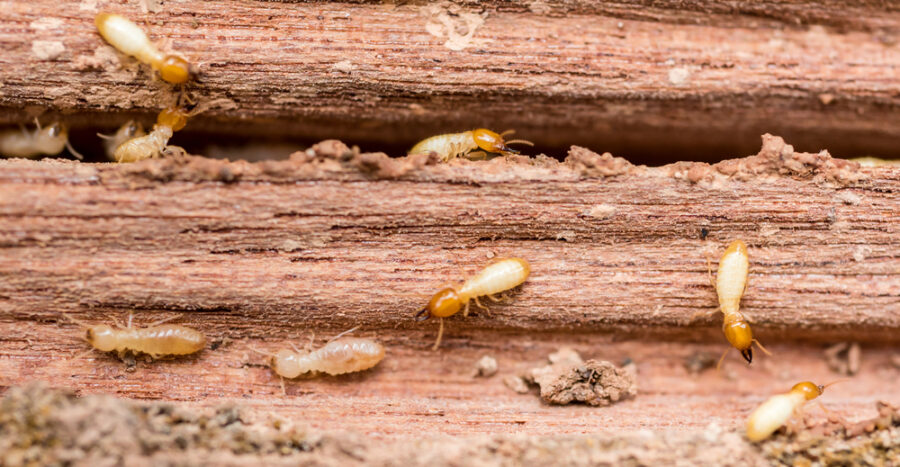Termites, often referred to as “silent destroyers,” are notorious pests that can wreak havoc on structures, furniture, and various wooden elements. These small, social insects belong to the order Isoptera and are known for their ability to consume wood silently and steadily. Understanding the damage caused by termites is crucial for homeowners, businesses, and anyone responsible for property maintenance. In this, we will explore the different aspects of damages by termites, their impact on structures, and effective measures for prevention and control.
-
Wood Damage:
Termites primarily feed on cellulose, a component found in wood and plant materials. As such, the damage caused by termites is most evident in wooden structures. The feeding habits of termites result in hollowed-out wood, leaving only a thin layer of paint or veneer on the surface. The destruction can be extensive, compromising the structural integrity of buildings, furniture, and other wooden items.
-
Structural Damage:
One of the most significant concerns associated with termite infestations is the potential for structural damage. Termites often target the support beams, joists, and wooden components in buildings, weakening them over time. This type of damage can lead to sagging floors, warped walls, and even structural failures in severe cases. Since termites work from the inside out, detecting structural damage early is challenging, emphasizing the importance of regular inspections.
-
Financial Impact:
The financial consequences of termite damage can be substantial. Repairing structural damage caused by termites may involve extensive renovations and, in severe cases, complete rebuilding. Homeowners may incur significant costs for both repairs and preventative measures. Additionally, the decreased property value resulting from termite damage can have long-term financial implications.
-
Furniture and Personal Items:
Termites are not limited to structural elements; they can also infest furniture and personal items made of wood or cellulose-based materials. Cabinets, bookshelves, antique furniture, and wooden decor are all susceptible to termite infestations. The loss of cherished possessions and the need for costly replacements contribute to the overall impact of termite damage.
-
Agricultural Damage:
While subterranean termites are the primary culprits in structural damage, other termite species can pose threats to agriculture. These termites feed on living plant tissues, including crops and trees. In agriculture, termite damage can result in reduced crop yields, stunted plant growth, and economic losses for farmers.
-
Hidden Infestations:
Termites are adept at staying hidden, making it challenging to detect infestations until significant damage has occurred. They build mud tubes to travel between their nests and food sources, often concealed behind walls or in hard-to-reach areas. This hidden nature of termite infestations underscores the importance of proactive measures, such as regular inspections and preventative treatments.
-
Health Concerns:
While termites themselves do not pose direct health risks to humans, the mold and fungi that thrive in damp, termite-damaged wood can contribute to indoor air quality issues. The weakened structure of infested buildings may also create safety hazards. Moreover, the stress and financial strain resulting from termite damage can impact the mental well-being of affected individuals.
-
Prevention and Control:
Given the destructive potential of termites, prevention and control measures are essential. These include:
– Regular Inspections: Conduct routine inspections for signs of termite activity, such as mud tubes, damaged wood, or discarded wings.
– Moisture Control: Termites are attracted to damp environments. Addressing moisture issues by fixing leaks and ensuring proper ventilation can deter termite infestations.
– Wood Treatment: Applying termite-resistant treatments to wooden structures and furniture can provide a protective barrier against infestations.
– Professional Pest Control Services: Engaging the services of professional pest control experts is crucial for effective termite management. These professionals can assess the extent of infestations, implement targeted treatments, and provide ongoing prevention strategies.
Conclusion:
Termites, though small in size, have the potential to cause significant and costly damage to structures, furniture, and agricultural crops. Recognizing the signs of termite infestations and implementing proactive prevention measures are vital for minimizing the impact of these silent destroyers. By understanding the nuances of termite behavior, homeowners, businesses, and agricultural stakeholders can work towards creating termite-resistant environments and preserving the integrity of their properties. Regular inspections, moisture control, and professional pest control services are key components of a comprehensive approach to mitigating termite damage and maintaining the longevity of wooden structures.

Leave a Reply